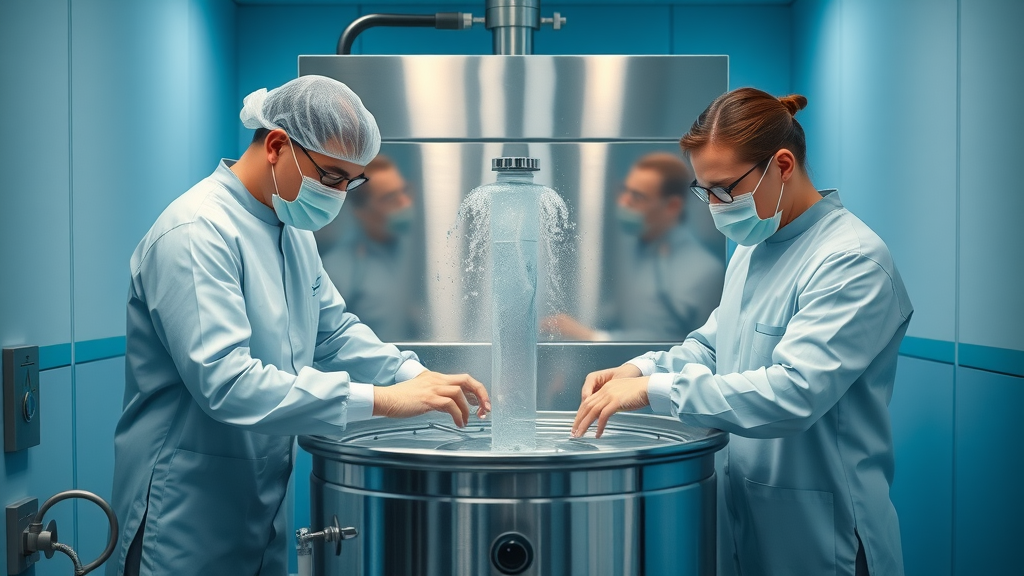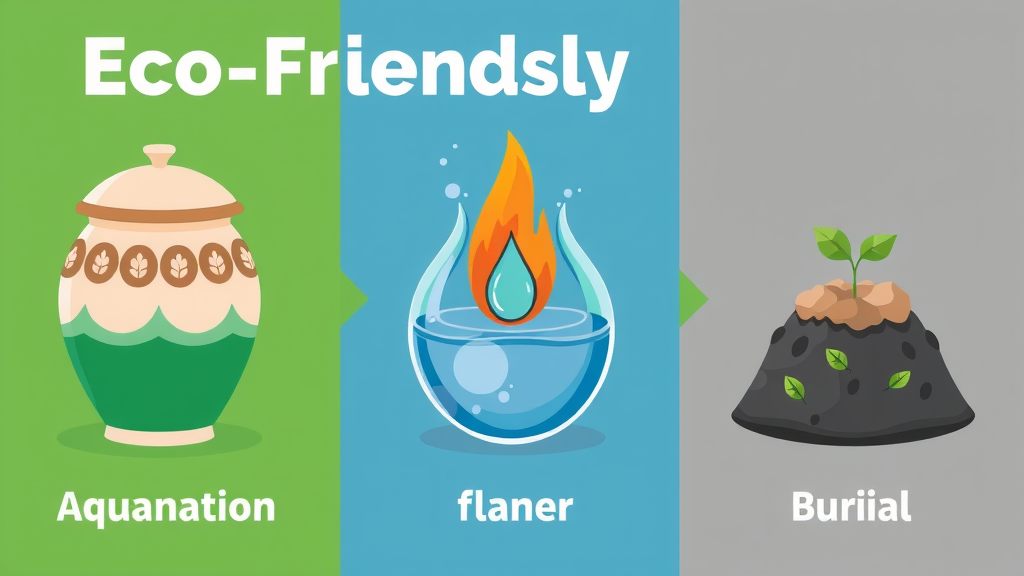Did you know that aquamation uses up to 90% less energy than traditional flame cremation? As families around the globe seek greener final goodbyes, what is aquamation has become a buzzword in the world of funerals. This environmentally friendly alternative to traditional funeral methods is gaining rapid popularity, offering a gentle process with a kinder impact on the Earth. In this guide, you'll discover why aquamation is shifting the paradigm for honoring loved ones and how it compares to more conventional end-of-life choices.
Opening Insights: The Rising Popularity of Aquamation
In recent years, aquamation—a process also known as alkaline hydrolysis—has emerged as a revolutionary approach within the funeral industry. As climate concerns push more people to question the sustainability of traditional cremation and burial practices, eco-conscious families are increasingly considering this friendly alternative. According to funeral industry sources and organizations like the Mayo Clinic, aquamation offers a solution that not only reduces energy consumption but also minimizes harmful emissions typically associated with flame cremation and traditional funeral services.
Funeral homes in places like North America, the United States, and South Africa are beginning to offer aquamation as part of their service options. This shift reflects a growing awareness of the environmental impact of conventional funeral practices and signals a broader cultural transformation. With public figures such as Desmond Tutu opting for this process, awareness is poised to soar even higher. For families seeking a respectful, cost-effective, and sustainable way to say goodbye, aquamation is quickly becoming the modern choice.

"Did you know that aquamation uses 90% less energy than traditional flame cremation?" – Industry Expert
What You’ll Learn About What is Aquamation
- Definition and process of what is aquamation
- Comparison with traditional funerals and water cremation
- Historical and global perspectives including South Africa and the United States
- Cost, legality, and FAQs surrounding what is aquamation
- Practical steps for choosing an eco-friendly alternative
What is Aquamation? Definition and Explanation
What is aquamation? Aquamation, also known as alkaline hydrolysis or sometimes water cremation, is a modern funeral practice that uses water, heat, and an alkaline solution—typically potassium hydroxide—to break down a human or pet body. Unlike traditional cremation, which uses flames and releases significant carbon dioxide, aquamation employs a gentle, natural process that returns organic material to a liquid form, leaving only bone fragments. These are then processed into a fine powder and returned to the family, similar to how ashes are handled after flame cremation.
The aquamation process involves placing the body in a specially designed stainless steel vessel, where water and the alkaline agent are heated and circulated. This process, called alkaline hydrolysis, mimics natural decomposition but accelerates it, taking about 6 to 8 hours. The result is a respectful, eco-friendly alternative that significantly reduces environmental footprint. Families often describe the aquamation procedure as more gentle and favorable for those seeking an environmentally friendly farewell.
For those weighing the differences between aquamation and more conventional options, it can be helpful to explore a detailed comparison of cremation versus funerals. Understanding the unique benefits and considerations of each method can guide families toward the most meaningful choice for their circumstances. For a comprehensive breakdown, see how cremation and traditional funerals compare in cost, process, and environmental impact.
Understanding the Aquamation Process: From Start to Finish
The journey of aquamation begins at the funeral home, where licensed professionals assist with all arrangements. The deceased is respectfully placed in a stainless steel vessel. A solution of 95% water and 5% potassium hydroxide is added, and the vessel is gently heated to around 150° Celsius. Through the alkaline hydrolysis process, the body is reduced to its most natural components: a sterile liquid and mineral bone fragments. The liquid contains amino acids, sugars, salts, and other organic material similar to natural soil nutrients. The remaining bone fragments are dried and processed into a powder that is returned to the family.
This gentle water process is completed in a controlled, dignified setting to ensure respect and privacy for the deceased and their loved ones. The sterile liquid is safely released into the local sewer system, where it poses no harm, while the processed remains can be placed in an urn, scattered, or memorialized in the manner families choose. Both human and pet aquamation follow similar protocols, emphasizing care and environmental stewardship throughout the process.

How Aquamation Differs from Water Cremation and Flame Cremation
Although terms like water cremation and aquamation are often used interchangeably, the distinction matters in funeral planning. Flame cremation, the traditional cremation process, exposes the body to high temperatures in a furnace, resulting in rapid combustion. This produces ash and releases greenhouse gases—including carbon dioxide—which contribute to a larger carbon footprint. By contrast, aquamation employs the alkaline hydrolysis process, using water and gentle heat to break down the body naturally and with far fewer emissions.
While both aquamation and flame cremation result in remnants that can be returned to the family, the aquamation remains are finer, whiter in color, and created through a natural process instead of combustion. Unlike traditional funerals (which require embalming fluids, caskets, and land use), aquamation leaves no toxic byproducts or need for physical burial space, positioning it as an environmentally friendly alternative for future generations.
The Science Behind Aquamation: Eco-Friendly Alternative Explained
What Happens During Aquamation? (People Also Ask)
During aquamation, a body is carefully placed into a steel vessel inside the funeral home or specialized facility. The chamber is filled with a solution that is primarily water mixed with a small amount of an alkali—commonly potassium hydroxide. The vessel gently heats this solution, causing the organic material of the body to break down through alkaline hydrolysis, just as would occur in natural soil over the course of years. This transformation is highly controlled, ensuring complete safety and a respectful environment throughout.
The process results in two byproducts: a sterile, nutrient-rich liquid and delicate bone remains. The liquid can be safely disposed of through the sewer system, and the bone fragments are processed into ash-like remains. These are returned to the family in a vessel or urn, used as part of a memorial. According to studies referenced by the Mayo Clinic and major funeral homes, this process is far more environmentally friendly than burning, making it a leading choice among those aware of tradition’s ecological consequences.
Aquamation vs Traditional Funeral Methods: Environmental Impact & Key Differences
| Method | Process | Environmental Impact | Average Cost (USD) | Remains/Output |
|---|---|---|---|---|
| Aquamation (Alkaline Hydrolysis) | Water, heat & alkali in steel vessel, 6–8 hours | Very low emissions, environmentally friendly alternative | $1,500–$3,000 | Fine, white ash; returned to the family |
| Flame Cremation | High-heat furnace, combustion, 2–3 hours | CO2 pollution; larger carbon footprint | $1,000–$2,500 | Ash residue; returned to the family |
| Traditional Burial | Embalming, casket, land plot | Land and resource use; embalming fluid pollution | $7,000–$10,000+ | Physical interment |
| Water Cremation | Same as aquamation—often used interchangeably | Very low emissions, natural form of decomposition | $1,500–$3,000 | Fine, white ash; returned to the family |

Celebrity Spotlight: Desmond Tutu’s Choice for Aquamation
South Africa’s Progressive Movement Towards Eco-Friendly Funerals
Global conversations about what is aquamation reached new heights when Archbishop Desmond Tutu, famed South African cleric and Nobel Peace Prize laureate, chose aquamation for his own funeral. This decision was seen as a remarkable endorsement of environmentally friendly alternatives by a prominent international figure. Tutu’s advocacy for sustainable practices inspired many, helping to destigmatize and raise awareness of aquamation in South Africa and beyond.
South Africa, a country rich in cultural traditions, has swiftly incorporated aquamation into its funeral options—thanks in part to Tutu’s example and shifting societal values. Funeral homes in cities such as Cape Town and Johannesburg report rising interest, especially among younger and environmentally conscious demographics. The country’s embrace of aquamation process showcases a global trend, pushing for more sustainable, respectful, and meaningful ways to commemorate loved ones without detriment to our planet’s future.

Global Adoption: United States and Beyond
The United States has seen a dramatic uptick in funeral homes providing aquamation as part of their eco-friendly service offerings, particularly in states like California, Oregon, and Minnesota. While not yet implemented everywhere due to varied state regulations, the option is rapidly expanding. In North America, wider adoption is expected as both public interest and regulatory frameworks evolve to reflect changing preferences. As with South Africa, the united states recognizes the need for friendly alternatives that minimize environmental impact while still honoring personal and religious traditions.
Other countries are also introducing aquamation, referred to by distinct names—such as Resomation in the UK and Australia. The common thread across all regions is a desire to balance respect for the deceased, spiritual beliefs, and sustainable stewardship. The rise of aquamation process is thus a direct response to evolving global attitudes toward death, grief, and environmental responsibility. Families worldwide can now choose funeral options that reflect their values without compromising ecological health.
Is Aquamation Cheaper Than Cremation? (People Also Ask)
Many families are surprised to learn that aquamation can be as affordable—or sometimes more affordable—than traditional cremation. The average cost for the aquamation process in the United States ranges between $1,500 and $3,000, closely mirroring, and occasionally undercutting, the price tag for flame cremation. Savings arise because no fossil fuels are burned, and there are fewer facility maintenance needs for water-based systems. This makes aquamation an appealing option for those who want to honor loved ones with minimal financial or environmental burden.
It’s also important to factor in the value of sustainability when considering cost. While traditional funerals and burials can exceed $10,000 due to elaborate caskets and land purchases, aquamation offers an economical solution without hidden fees. Families should speak with local funeral homes to understand pricing in their state or province and evaluate all potential expenses, including urns and memorial options. If cost efficiency, eco-consciousness, and dignity are key priorities, aquamation is often the friendly alternative of choice.
Understanding Legal Status: Why is Aquamation Illegal in Some States? (People Also Ask)
Despite its benefits, aquamation is not legal everywhere. In the United States, its availability depends on state law and varying interpretations of what constitutes an approved funeral practice. Some states—such as North Carolina—currently prohibit or restrict aquamation due to outdated statutes or lack of regulatory frameworks, while others actively support it through legislation. Major impediments include misconceptions about water disposal, religious and cultural hesitancy, and the time needed for policy change.
Advocacy groups and environmental organizations are working to educate lawmakers and the public about the safety, dignity, and eco-friendliness of the aquamation process. Most scientific research, including data cited by the Mayo Clinic, demonstrates that the sterile liquid byproduct can be safely released into the sewer system without environmental harm. As more states modernize their funeral laws, legal access to aquamation is likely to expand, offering families everywhere a greater array of respectful choices.
Is Aquamation Painful? Dispelling Myths (People Also Ask)
One of the most persistent myths concerns whether aquamation is “painful,” but the truth is simple: aquamation is performed after death and causes no pain or sensation. The process is entirely respectful and clinical, carried out by trained technicians in a dignified setting, often at a funeral home or specialized facility. From beginning to end, the alkaline hydrolysis process ensures the body is treated with the utmost care.
This misperception often stems from misunderstanding what happens during aquamation and confusion with other forms of body disposition. Whether you choose aquamation for a loved one or a beloved pet, you can be assured the method is gentle, humane, and completely pain-free. Addressing these misconceptions allows families to focus fully on memorializing loved ones in ways that reflect both compassion and environmental responsibility.
Working with Funeral Homes: How to Arrange for Aquamation
- Research state/local laws about aquamation: Start by verifying if the process is legal and available in your state or locality. Contact your state health department or a reputable funeral home for current regulations.
- Find a funeral home offering aquamation services: Not every funeral home provides aquamation, so ask specifically about “alkaline hydrolysis” or “water cremation” options.
- Discuss your wishes with family and service providers: Transparent communication ensures that everyone understands and respects your choice of an environmentally friendly alternative.
- Understand the process for remains and memorial options: Funeral homes can help you select urns or guide you in memorializing your loved one in a way that honors your values.
Lists: Pros and Cons of Aquamation vs. Traditional Funeral Choices
- Lower environmental impact (eco-friendly alternative)
- Comparable costs to flame cremation
- Limited availability in some regions
- Gentle, respectful process
- Not universally legal
Frequently Asked Questions (FAQs) About What is Aquamation

-
Is aquamation available at every funeral home?
No; aquamation is offered only at select funeral homes, primarily in states where it’s legal. Always confirm availability before planning. -
How do aquamation remains differ from cremation ashes?
Remains from aquamation are finer, whiter, and consist solely of bone minerals. They’re often regarded as cleaner than those produced by flame cremation. -
Are there religious considerations with aquamation?
Yes. Some religious traditions have specific teachings on burial and cremation. Families should consult their faith community for guidance. -
What permits or documentation are required?
You may need a death certificate, disposition permit, and potentially additional paperwork, depending on your state or country’s laws.
Key Takeaways: Why Consider Aquamation?
- Aquamation is a friendly alternative with lower energy consumption.
- Supports environmental sustainability.
- Increasingly recognized in the United States, South Africa, and globally.
Video: What is Aquamation? (Expert Interview and Overview)
Expert interview video explaining what is aquamation, the science behind the process, its environmental benefits, and how families can choose this funeral option.
Video: How Aquamation Works – Step-by-Step Process
Conclusion: Embracing What is Aquamation in Modern Funeral Practices
Aquamation offers a respectful, eco-friendly, and increasingly accessible alternative to traditional funerals—ideal for families seeking meaningful and sustainable ways to honor loved ones.
As you consider the best way to honor a loved one, it's valuable to look beyond the process itself and reflect on the broader journey of remembrance and support. Many families find comfort and guidance in resources that help them navigate the emotional and practical aspects of saying goodbye. If you're interested in compassionate approaches and meaningful traditions for memorializing those who matter most, discover thoughtful strategies in helping families honor their loved one with dignity and care. Exploring these insights can empower you to create a farewell that truly reflects your values and the unique legacy of your loved one.
Aquamation, also known as alkaline hydrolysis or water cremation, is an eco-friendly alternative to traditional burial and flame-based cremation. This process uses a combination of water, heat, and alkaline chemicals to accelerate the natural decomposition of the body, resulting in a sterile liquid and bone remains. The bone fragments are then processed into a fine powder, similar to ashes from traditional cremation, and returned to the family. (theguardian.com)
One of the significant advantages of aquamation is its minimal environmental impact. The process consumes about 90% less energy than flame-based cremation and produces no direct emissions of harmful greenhouse gases. Additionally, it avoids the release of mercury from dental amalgams, which can occur during traditional cremation. (bafca.org)
The legality and availability of aquamation vary by location. As of May 2025, 28 U.S. states have authorized the process for human remains, with Minnesota being the first to do so in 2003. However, in some regions, aquamation remains prohibited or unregulated due to existing statutes or lack of regulatory frameworks. (cremationadvisor.org)
Notably, Archbishop Desmond Tutu chose aquamation for his own funeral, highlighting its growing acceptance as a sustainable end-of-life option. His choice brought significant attention to the process and its environmental benefits. (theguardian.com)
In summary, aquamation offers a gentle, environmentally friendly alternative to traditional funeral practices, aligning with the values of those seeking sustainable options for honoring their loved ones.
 Add Row
Add Row 

 Add
Add 


Write A Comment